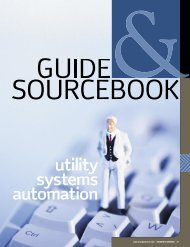Create successful ePaper yourself
Turn your PDF publications into a flip-book with our unique Google optimized e-Paper software.
32 EnErgyBiz magazinE March/April 2007
A P P h o t o / S A n d y h u f f A k E r )<br />
Sempra<br />
aggreSSively<br />
purSueS<br />
OppOrtunitieS<br />
By al Senia<br />
More than four years ago, top executives with<br />
California energy giant Sempra identified a major opportunity<br />
developing in the natural gas market. Their prediction<br />
<strong>of</strong> an impending natural gas shortage drew criticism<br />
from numerous quarters, but they pushed forward with<br />
an ambitious and somewhat risky multi-billion-dollar<br />
investment in liquefied natural gas development.<br />
Now, with the first <strong>of</strong> Sempra’s <strong>LNG</strong> receiving terminals<br />
scheduled to start operating early next year on Mexico’s west<br />
coast about 50 miles south <strong>of</strong> San Diego, the $15 billion<br />
company is at the forefront <strong>of</strong> the domestic <strong>LNG</strong> industry.<br />
It is also cementing a diversification strategy that positions<br />
it far beyond its core utility businesses, Southern California<br />
Gas Co. and San Diego Gas & Electric Co.<br />
In fact, it is Sempra’s commitment to diversification<br />
— and its desire to leverage its various business components<br />
— that help explain its multi-billion-dollar gamble<br />
on <strong>LNG</strong> development. The <strong>LNG</strong> operation is just one<br />
segment <strong>of</strong> Sempra Global, the nonutility family <strong>of</strong><br />
businesses that operate in a competitive marketplace and<br />
that includes power generation, pipeline and storage, and<br />
an energy trading company. They comprised more than 40<br />
percent <strong>of</strong> Sempra’s total revenue last year.<br />
“What <strong>LNG</strong> is for Sempra is a catalyst for growth in our<br />
associated businesses,” explained Darcel Hulse, president <strong>of</strong><br />
Sempra <strong>LNG</strong>. “As we move forward in our <strong>LNG</strong> business,<br />
that provides an opportunity for a better understanding <strong>of</strong><br />
the market for our trading group to participate on a global<br />
scale, as well as our pipeline and storage group.”<br />
Fundamentally, Hulse and other Sempra executives see a<br />
growing need for natural gas worldwide and adequate supplies<br />
in many parts <strong>of</strong> the world that have small local markets and<br />
the desire to export their supplies. “On an energy-equivalent<br />
basis, proven gas reserves now exceed proven oil reserves,” said<br />
Hulse. “So there is more energy locked in gas than there is in<br />
oil. As we analyze that going forward, it means gas is going to<br />
take a more predominant role in our energy mix.”<br />
To meet that need, Sempra has invested an estimated<br />
$2.2 billion in developing three <strong>LNG</strong> receiving terminals in<br />
Baja, Mexico, in Port Arthur, Texas and near Lake Charles, La.<br />
The $800 million Baja facility is the most interesting<br />
because it will be the first <strong>of</strong> its kind on the Pacific Coast.<br />
A construction worker<br />
at Sempra Energy’s new<br />
Energia Costa Azul facility<br />
in Baja Mexico<br />
www.energycentral.com EnErgyBiz magazinE 33
Sempra Energy’s new<br />
Energia Costa Azul, South<br />
<strong>of</strong> rosarito, in Baja Mexico.<br />
34 EnErgyBiz magazinE March/April 2007<br />
A similar <strong>LNG</strong> facility <strong>of</strong>f the coast <strong>of</strong> Long Beach, Calif.,<br />
backed by Mitsubishi-ConocoPhillips, was all but killed<br />
in January because <strong>of</strong> safety and environmental concerns.<br />
The Baja plant, named Costa Azul, is the first Sempra <strong>LNG</strong><br />
plant scheduled to come online. It is expected to process<br />
1 billion cubic feet (Bcf) per day <strong>of</strong> natural gas when it<br />
begins commercial operation early next year. Officials hope<br />
to eventually increase daily production to 2.5 Bcf. Sempra<br />
plans to sell about one-half <strong>of</strong> initial production in the<br />
western United States and the other half in Baja, Mexico.<br />
“It’s moving along very well and construction is coming<br />
along,” Hulse said.<br />
The second Sempra plant, Cameron <strong>LNG</strong> near Lake<br />
Charles, La., will process 1.5 Bcf per day <strong>of</strong> natural gas<br />
when it begins operation in late 2008. The third plant, Port<br />
Arthur <strong>LNG</strong>, is under development along the Port Arthur<br />
Ship Canal on the Gulf Coast. It is expected to deliver<br />
between 1.5 Bcf and 3.0 Bcf per day <strong>of</strong> natural gas in 2010.<br />
LEAdInG thE PACk<br />
Sempra haS<br />
been at the<br />
forefront <strong>of</strong><br />
bringing Lng to<br />
the United StateS<br />
<strong>LNG</strong> industry pundits believe Costa Azul puts Sempra a big<br />
step ahead <strong>of</strong> competitors because it will provide a needed<br />
West Coast outlet for natural gas producers and marketers.<br />
“It’s a huge development in terms <strong>of</strong> the global <strong>LNG</strong><br />
business because it opens up the West Coast market,” noted<br />
Damian Gaul, an economist with the Energy Information<br />
Administration who in January co-authored a report about<br />
the global <strong>LNG</strong> market. “Sempra has been at the forefront <strong>of</strong><br />
bringing <strong>LNG</strong> to the United States. That is a big deal because<br />
they will be able to bring in new supplies <strong>of</strong> natural gas.”<br />
According to the Federal Energy Regulatory<br />
Commission, which has regulatory authority over <strong>LNG</strong><br />
plant development, there are 40 <strong>LNG</strong> terminals currently<br />
being discussed with six currently operating <strong>of</strong>f the East<br />
Coast, the Gulf Coast and Puerto Rico. Analysts predict only<br />
about 12 <strong>of</strong> the 40 plants will ultimately be built, thanks to
independence.<br />
“I’m no rocket scientist, but ImageNow is so<br />
intuitive that anyone can use it. Even employees<br />
who don’t <strong>of</strong>ten use ImageNow fi nd it easy to<br />
quickly pull up the documents they need.”<br />
Leon Chain<br />
Ad Place<br />
Holder<br />
Controller, Mid-Atlantic Region<br />
Aqua America, Inc.<br />
ImageNow integrated document<br />
management, imaging and workfl ow<br />
The right document management and imaging solution gives you plenty <strong>of</strong><br />
support when you need it, but is built to make sure you won’t need it much.<br />
Perceptive S<strong>of</strong>tware gave ImageNow a uniquely intuitive design, making it<br />
simple for users to learn, modify and make it their own.<br />
ImageNow creates a direct and effortless connection between you and<br />
the fi les you need to complete your daily business activities. With a rapid,<br />
patented integration style that works instinctively with your existing business<br />
s<strong>of</strong>tware applications, ImageNow requires no programming and is practically<br />
maintenance-free.<br />
Freedom. It’s a beautiful thing.<br />
www.imagenow.com/utilities<br />
The documents<br />
you need. Now.<br />
© 2006 Perceptive S<strong>of</strong>tware, Inc. ImageNow is a registered trademark <strong>of</strong> Perceptive S<strong>of</strong>tware, Inc. All other product and company names may be<br />
trademarks or registered trademarks <strong>of</strong> their respective owners. ad_energybiz0612
Another view <strong>of</strong> Sempra<br />
Energy’s new Energia<br />
Costa Azul<br />
36 EnErgyBiz magazinE March/April 2007<br />
the complex political, environmental and regulatory hurdles<br />
that <strong>LNG</strong> plants must overcome before being built.<br />
New <strong>LNG</strong> plants clearly are needed if the technology<br />
is to gain traction because the volume <strong>of</strong> <strong>LNG</strong> imports<br />
decreased during the past two years. In his EIA report,<br />
Gaul noted that <strong>LNG</strong> “still accounts for less than 3 percent<br />
<strong>of</strong> total U.S. natural gas supplies, but the global market<br />
is growing, and EIA foresees another wave <strong>of</strong> U.S. <strong>LNG</strong><br />
growth over the next two years.”<br />
As global <strong>LNG</strong> supplies grow, EIA predicts domestic<br />
<strong>LNG</strong> imports will increase 34.5 percent this year and 38.5<br />
percent next year. Sempra’s plan may position it well to<br />
compete in this growing market. “They are taking a risk, but<br />
it will be rewarded,” said Gaul. “There’s no lack <strong>of</strong> proposals<br />
to build these facilities, but <strong>of</strong>tentimes, the proposals are<br />
not very well formulated” and they quickly die. He noted<br />
that for its part, Sempra “has already gone through a lot <strong>of</strong><br />
different hurdles to get to where it is now. It’s ahead on the<br />
West Coast <strong>of</strong> North America, and the market is going to<br />
open up a lot.”<br />
oIL PArALLEL<br />
Sempra’s Hulse sees a parallel between development <strong>of</strong> the<br />
global <strong>LNG</strong> industry and the oil industry. “As <strong>LNG</strong> grows<br />
around the world, we’ll start seeing <strong>LNG</strong> trading a lot more<br />
like a commodity, much like there is in oil,” he said. ”<strong>LNG</strong><br />
will be a prominent commodity like oil. It’s going to require<br />
a lot more infrastructure globally.”<br />
The oil industry “provides a good history for us to look<br />
at,” Hulse added. “It will move like that.” Hulse conceded<br />
that <strong>LNG</strong> is still much less developed as an industry than<br />
the oil business, and it is “very difficult to put all the pieces<br />
together, simply because <strong>of</strong> the liquefication process. On<br />
the oil side, “what we do upstream with <strong>LNG</strong>, we do<br />
downstream with oil.” An oil refinery translates crude
oil into products that are traded globally. He believes the<br />
natural gas liquefaction technology central to <strong>LNG</strong> “allows<br />
you to move it around the planet like oil.”<br />
How long will that take? “It’s hard to predict,” Hulse<br />
said. “If you look at the history <strong>of</strong> oil, oil traded locally and<br />
then it traded regionally and then it traded globally. <strong>LNG</strong><br />
has done the same thing… There’s a period <strong>of</strong> transition<br />
from a bilateral market to a global-commodity market. It<br />
will move like oil. How long it will take I can’t predict. All I<br />
can tell is that there is a trend moving in that direction.”<br />
Gaul agreed there are some similarities in <strong>LNG</strong> and oil<br />
in that a global market is developing for both commodities<br />
and both are being transported to different, far-flung<br />
geographies. “It is reasonable because <strong>of</strong> the companies<br />
involved and the countries,” said Gaul, noting that <strong>LNG</strong><br />
imports to the United States come from countries such as<br />
Egypt, Nigeria and Libya. Two-thirds <strong>of</strong> U.S. imports last<br />
year, however, came from Trinidad and Tobago. “You find<br />
natural gas where you find oil. Spot trade in <strong>LNG</strong> is starting<br />
to develop. But a spot market that comes close to imitating<br />
the oil market is still many years away. And the transportation<br />
cost for natural gas is a lot more than for oil. So there<br />
is not going to be much liquidity in the marketplace.”<br />
Another detriment for <strong>LNG</strong> is that<br />
unlike oil, it costs a lot more capital to build<br />
a liquefication processing facility — and the<br />
environmental and political obstacles are <strong>of</strong>ten<br />
immense. Even so, Hulse’s proposition isn’t so<br />
far-fetched, especially if natural gas emerges as<br />
the fuel <strong>of</strong> choice for developed countries.<br />
For Sempra’s part, such forward thinking<br />
plays right into the company’s strategy <strong>of</strong><br />
staying ahead <strong>of</strong> the curve. “We come at it<br />
from a market focus,” said Hulse. “We’re an<br />
infrastructure builder <strong>of</strong> <strong>LNG</strong> pipelines and generation.<br />
Plus tied into all <strong>of</strong> that, we have the ability <strong>of</strong> a trading<br />
company.<br />
“The important thing is to see market trends and<br />
movements before they become very clearly evident to the<br />
rest <strong>of</strong> the market,” added Hulse. “We started early, we got<br />
ahead <strong>of</strong> the cost curve, so we now can <strong>of</strong>fer good services<br />
and strategic locations. We will always try to stay ahead.<br />
That’s why this market-based approach is important. We<br />
spend a lot <strong>of</strong> time trying to study market trends. We’ve had<br />
to take contrarian views in pursuing this. If you can spot the<br />
trends in advance and position yourself, you’ll benefit.”<br />
Ad Place<br />
Holder<br />
darcel hulse, president<br />
<strong>of</strong> Sempra LnG.<br />
Some systems avoid the dirty work. We say bring it on.<br />
Spending time in the field is a fact <strong>of</strong> life for utilities. Sometimes, things can get a little messy,<br />
which is fine…as long as you don’t get bogged down.<br />
Neptune’s FieldNet® s<strong>of</strong>tware by DB Microware makes your time in the field as efficient<br />
and productive as possible. FieldNet can combine full route control, meter reading,<br />
collections, and meter-related service order capabilities using our rugged, portable<br />
field devices, reducing your utility’s labor costs while increasing efficiency and cash<br />
flow. FieldNet is fully customizable, so it is easily integrated into your environment<br />
with minimal impact to back <strong>of</strong>fice systems, and it can read multiple AMR technologies, including all Neptune<br />
R900®s and Itron electric ERTs.<br />
With FieldNet, you get a system that’s tough enough – and smart enough – to excel in any environment.<br />
For more information, contact Neptune today.<br />
Take Control. neptunetg.com ARB® UTILITY MANAGEMENT SYSTEMS WATER | ELECTRIC | GAS<br />
1600 Alabama Highway 229, Tallassee, AL 36078 • 334.283.6555 • 1.800.633.8754<br />
www.energycentral.com EnErgyBiz magazinE 37



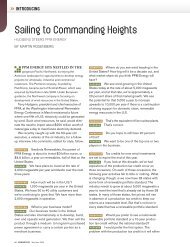
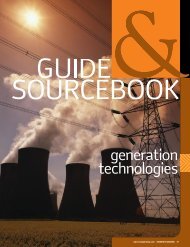
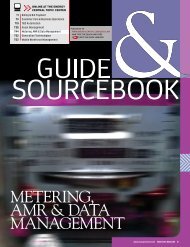


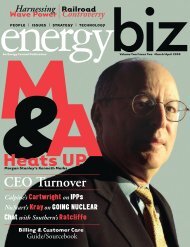

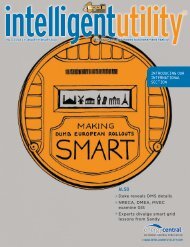

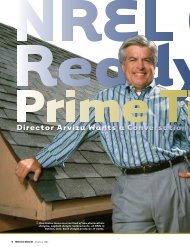


![View From the Trenches [PDF]](https://img.yumpu.com/18854438/1/190x252/view-from-the-trenches-pdf.jpg?quality=85)
